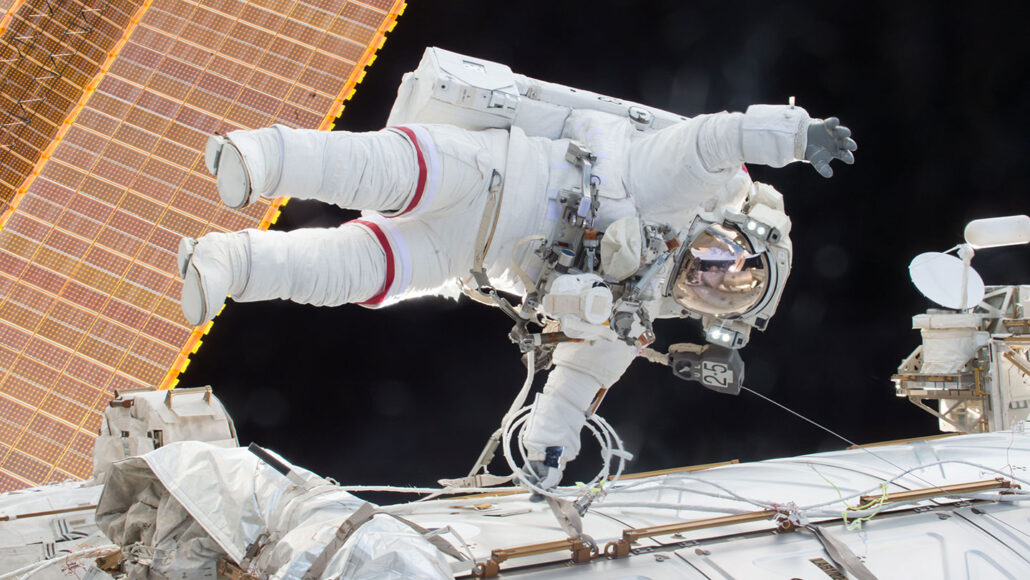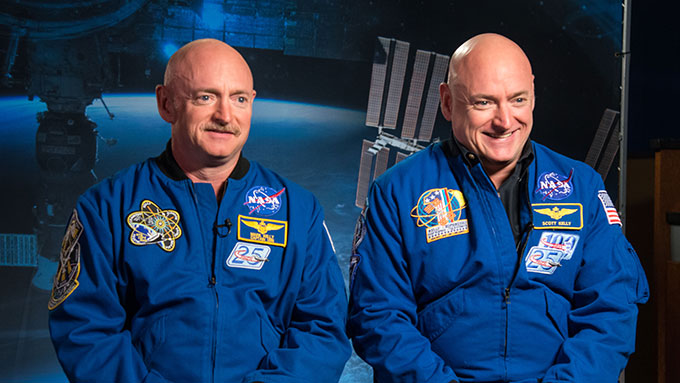Space travel may harm health by damaging cells’ powerhouses
Astronauts and animals that spent time in space show similar symptoms

After a year in space, astronaut Scott Kelly (seen here on a spacewalk in December 2015) experienced changes in his mitochondria — energy-producing structures in cells — a new study finds.
NASA
By Jack J. Lee
Space travelers face a number of health risks. Astronauts have reported loss of bone and muscle. Some have developed immune disorders or heart and liver issues. A new study finds that energy-producing structures in cells might be to blame for many of these problems. That finding could guide treatments for future astronauts en route to such faraway places as Mars.
As a systems biologist, Afshin Beheshti studies how multiple parts of the body work together. He works for KBR at the NASA Ames Research Center in Moffett Field, Calif. KBR is a research and engineering company. Beheshti is part of a team of researchers who wanted to know how spaceflight might affect cells and tissues. “It’s a basic question,” he notes. When in space, “is there some sort of master switch that occurs in your body’s biology?”
The team consulted NASA GeneLab. It’s a collection of data from past space biology experiments. The scientists studied cells and tissues from mice and people. They were looking for a possible chemical fingerprint of space travel. To do this, they compared space travelers with others that had remained on Earth.
“The idea is not only to look at one type of [chemical],” Beheshti says. Rather, they wanted to “look at the [living] system as a whole.” And in doing that, they found a common theme. Mitochondria (MY-toh-KON-dree-uh) are the energy powerhouses of cells. And after time in space, mitochondria often didn’t work as well as they should.
Those findings are consistent with samples from NASA’s Twin Study. Before retiring, astronaut Scott Kelly spent nearly a year aboard the International Space Station. His twin, Mark, remained on the ground. Afterward, blood samples from the two showed different mitochondrial activity.

Changes in space
For the latest study, Beheshti and his team studied GeneLab data for many types of cells and tissues. The researchers looked at proteins and RNAs in each sample. (RNAs are genetic bits that help cells carry out instructions stored in DNA.) The researchers also looked for epigenetic changes to DNA. Those are chemical switches that can develop on the outside of genes. These may inappropriately turn genes on or off, or affect how well they work.
Another focus was molecules related to metabolism (Meh-TAB-oh-lism). That process includes a mix of chemical activities that supports life in cells, organs and whole organisms. These activities range from eating (energy consumption) to burning calories, making new cells and shedding wastes.
The team also examined blood and urine from 59 astronauts. Spaceflight seemed to have caused many biochemical changes in them. One symptom: Space travelers had more chemicals known to trigger inflammation. The researchers also found signs of oxidative stress, a type of cell damage. That damage can be due to poorly functioning mitochondria.
The chemical findings reflected the types of health issues seen in astronauts. For instance, some astronauts have developed liver problems. And computer models using GeneLab data predicted chemical changes in mouse livers linked to scarring. Mouse organs sent to space also had higher levels of RNAs that play a role in the body’s innate immunity. This immune system sends white blood cells to attack invaders, such as bacteria. Such an immune imbalance could match up with the high levels of inflammatory markers found in astronauts’ blood.
Damage to mitochondria may be a common factor in spaceflight health risks, the team now concludes.
Finding similar changes in so many astronauts indeed points to some general effect, agrees Michael Snyder. He’s a systems biologist at Stanford University in California. Snyder worked on Scott and Mark Kelly’s Twin Study but was not part of the new analysis.
If mitochondria are the culprit, targeting them could help protect future astronauts. Some diseases cause mitochondrial defects. Drugs used to treat such diseases may reduce astronauts’ health risks. “We don’t have to reinvent the wheel,” Beheshti says. Future studies could test if existing drugs prevent mitochondrial problems in cells, animals and people on long deep-space voyages.







